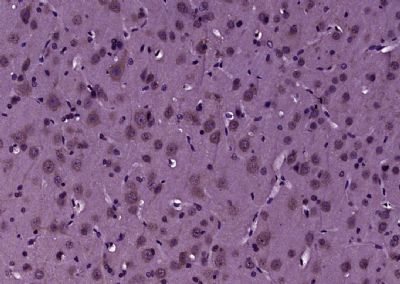MLC1 is a 377 amino acid multi-pass membrane protein that may serve as a non-selective neuronal cation channel in brain. Mutant MLC1 proteins that show impaired folding have been corrected in vitro with the addition of a Ca(2+)-ATPase inhibitor, curcumin. Mutations in the gene encoding MLC1 is the cause of megalencephalic leukoencephalopathy with subcortical cysts, also known as van der Knaap disease, a rare syndrome characterized early in life by progressive brain destruction causing mental retardation and incoordination. Single nucleotide polymorphisms within the MLC1 gene may be associated with periodic catatonia, but there seems to be conflicting evidence on whether or not the gene is implicated in general schizophrenia.
Function:
May be a transporter. May act as a non-selective neuronal cation channel.
Subunit:
Interacts with ATP1B1. Part of a complex containing ATP1B1, TRPV4, AQP4 and HEPACAM.
Subcellular Location:
Membrane; Multi-pass membrane protein (Potential). Cell membrane. Cytoplasm, perinuclear region. Endoplasmic reticulum.
Tissue Specificity:
Expressed in the brain, with highest levels found in the amygdala, nucleus caudatus, thalamus and hippocampus.
DISEASE:
Defects in MLC1 are a cause of leukoencephalopathy megalencephalic with subcortical cysts (MLC) [MIM:604004]. MLC is a syndrome of cerebral leukoencephalopathy and megalencephaly characterized by ataxia, spasticity, seizures, delay in motor development and mild mental retardation. The brain appears swollen on magnetic resonance imaging, with diffuse white-matter abnormalities and the invariable presence of subcortical cysts in frontal and temporal lobes.
SWISS:
Q15049
Gene ID:
2649
Database links:
Entrez Gene: 2649 Human
Entrez Gene: 170790 Mouse
Entrez Gene: 315215 Rat
Omim: 605908 Human
SwissProt: Q15049 Human
SwissProt: Q8VHK5 Mouse
Unigene: 517729 Human
Unigene: 32780 Mouse
| Picture |
Paraformaldehyde-fixed, paraffin embedded (Rat brain); Antigen retrieval by boiling in sodium citrate buffer (pH6.0) for 15min; Block endogenous peroxidase by 3% hydrogen peroxide for 20 minutes; Blocking buffer (normal goat serum) at 37°C for 30min; Antibody incubation with (MLC1) Polyclonal Antibody, Unconjugated (SL7115R) at 1:400 overnight at 4°C, followed by operating according to SP Kit(Rabbit) (sp-0023) instructionsand DAB staining.
|
|
|
